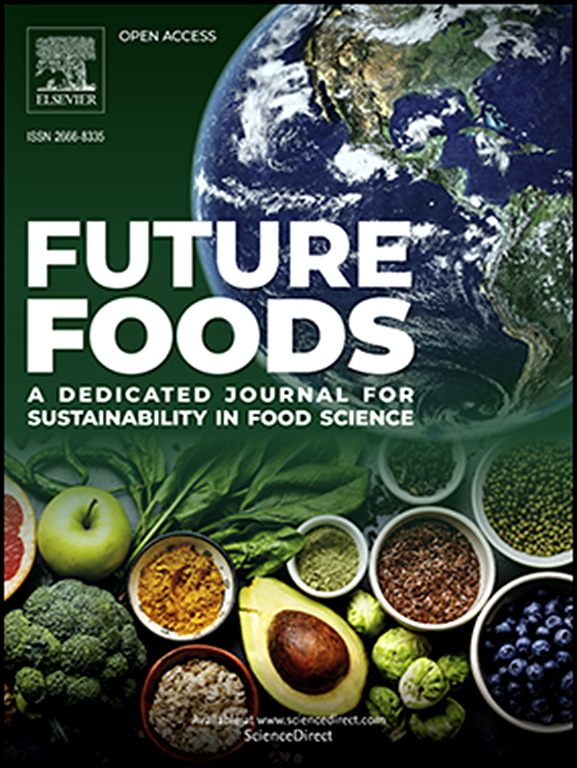Effect on 3D-printability and microstructure of pork paste partially replaced with yellow mealworm larvae paste
IF 8.2
Q1 FOOD SCIENCE & TECHNOLOGY
引用次数: 0
Abstract
Yellow mealworm larvae (Tenebrio molitor L.) (YML) are a readily available source of non-conventional protein with high nutritional value and feed conversion efficiency. However, they remain unaccepted by most consumers. This study examines the feasibility of substituting pork paste with YML paste (YMLP) at graded substitution levels (0–75 %), while concurrently evaluating the resultant effects on both nutritional composition and 3D-printing performance parameters in pork-YML composite matrices. Proximate composition analysis showed that YML substitution elevated ash content while maintaining baseline protein levels in the composite matrices, concurrently enhancing the overall nutritional profile of the experimental samples. The mixed pastes’ 3D printability was determined by measuring their rheological and microstructural properties. The Fourier-transform infrared spectroscopy results showed that the addition of YML increased the content of chitin, and the disentanglement and reorientation of chitin resulted in a decrease in viscosity and an increase in shear-thinning behavior which are shown in the rheological results. The texture profile analysis showed that the hardness, resilience, cohesiveness, and chewiness of the steamed 3D-printed samples were reduced with an increase in the YMLP replacement ratio (P < 0.05), which was due to the destruction of the 3D gel network as shown in scanning electron microscopy. Overall, while increasing the YMLP replacement ratio reduced the self-supporting capacity of printed samples and disrupted the 3D gel network structure, consequently diminishing printability and textural properties, successful substitution was achieved at a 30 % ratio. This optimal substitution level maintained functional performance while enhancing the nutritional profile of the pork-based matrices.
黄粉虫幼虫部分替代猪肉膏体对其3d打印性能和微观结构的影响
黄粉虫幼虫(Tenebrio molitor L.) (YML)是一种营养价值高、饲料转化率高的非常规蛋白质来源。然而,它们仍然不被大多数消费者所接受。本研究考察了用YML浆料(YMLP)在分级替代水平(0 - 75%)上替代猪肉浆料的可行性,同时评估了由此产生的对猪肉-YML复合基质营养成分和3d打印性能参数的影响。近似成分分析表明,YML替代提高了复合基质中灰分含量,同时保持了蛋白质的基线水平,同时提高了实验样品的整体营养状况。混合浆料的3D打印能力是通过测量其流变学和微观结构特性来确定的。傅里叶红外光谱分析结果表明,YML的加入增加了甲壳素的含量,甲壳素的解缠和重定向导致了粘度的降低和剪切减薄行为的增加,这在流变学结果中得到了体现。织构分析表明,蒸制后的3d打印样品的硬度、回弹性、黏结性和咀嚼性随着YMLP替代率(P <;0.05),这是由于扫描电镜显示的三维凝胶网络被破坏所致。总体而言,虽然增加YMLP替代率会降低打印样品的自支撑能力,破坏3D凝胶网络结构,从而降低打印性和纹理性能,但在30%的比例下成功实现了替代。这种最佳替代水平保持了功能性能,同时增强了猪肉基基质的营养成分。
本文章由计算机程序翻译,如有差异,请以英文原文为准。
求助全文
约1分钟内获得全文
求助全文
来源期刊

Future Foods
Agricultural and Biological Sciences-Food Science
CiteScore
8.60
自引率
0.00%
发文量
97
审稿时长
15 weeks
期刊介绍:
Future Foods is a specialized journal that is dedicated to tackling the challenges posed by climate change and the need for sustainability in the realm of food production. The journal recognizes the imperative to transform current food manufacturing and consumption practices to meet the dietary needs of a burgeoning global population while simultaneously curbing environmental degradation.
The mission of Future Foods is to disseminate research that aligns with the goal of fostering the development of innovative technologies and alternative food sources to establish more sustainable food systems. The journal is committed to publishing high-quality, peer-reviewed articles that contribute to the advancement of sustainable food practices.
Abstracting and indexing:
Scopus
Directory of Open Access Journals (DOAJ)
Emerging Sources Citation Index (ESCI)
SCImago Journal Rank (SJR)
SNIP
 求助内容:
求助内容: 应助结果提醒方式:
应助结果提醒方式:


